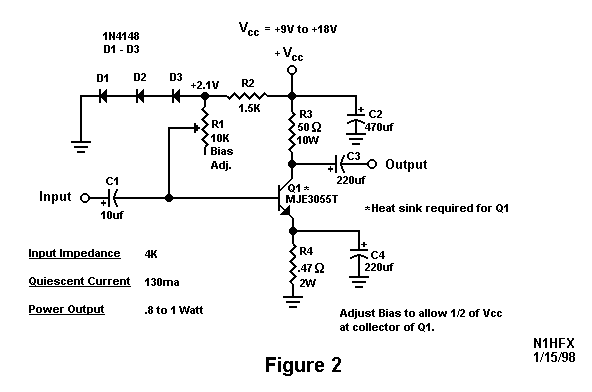
|
A Potpourri of Audio Amplifiers |
By N1HFX |
At a recent RASON meeting, I gave a presentation of how to design audio preamplifiers. I thought it would be nice if we could now build some audio amplifiers to bring the output from these preamplifiers to levels which could drive a speaker. I intentionally avoided the use of IC amplifiers to provide a real learning experience for audio amplifier design. Although many IC amplifiers provide excellent performance at low cost, we need to learn the basics first. I will address IC audio amplifiers in a future article.
Figure 1 is an interesting audio amplifier which provides almost a watt of audio with a very low standby current of only 45 milliamps. This circuit is really a current repeater formed by Q2 and Q3 and driven by Q1. This circuit is similar in performance to many IC amplifiers but requires an initial bias adjustment. R2 controls the bias and should be adjusted so that exactly ½ of the supply voltage is measured at the collector of Q3 with no signal. Once adjusted, heat sinks are not needed for Q2 and Q3 and a very high input impedance of approximately 47,000 ohms is seen at the input. Diodes D1 through D4 provide a constant voltage of 2.8 volts and form a constant current source through the base of Q1. This circuit is almost as good as some audio amplifier IC's and is preferred when a minimum power drain is needed.
The circuit in Figure 2 is a classic Class A audio amplifier utilizing the same biasing system as in the circuit of Figure 1. While it is possible to set the bias by using only 2 resistors, this does not give the flexibility to operate from a wide range of supply voltages. By adjusting the bias manually, we can optimize the amplifier and guarantee that ½ of our supply voltage appears at the output no matter what the supply voltage is. This arrangement gives us maximum power out with minimum distortion. The circuit in figure 2 features low distortion and very low noise at the expense of a much larger standby current. Of course, this large standby current requires a heat sink for Q1. Resistor R4 prevents thermal runaway and it is bypassed by C4 to maximize gain. The actual gain obtained will vary depending on the HFE of the transistor used along with the supply voltage. I recently built two of these circuits and used them as a stereo booster amp for a portable CD player with excellent results.
The circuit in Figure 3 features a power MOSFET operating at class A. This circuit is particularly interesting because of the low parts count. The bias should be set for ½ of the supply voltage at the drain of Q1 as in the previous circuits. There is no resistor at the source of the transistor simply because thermal runaway is not a problem for power MOSFET's. This circuit has a large standby current requiring a heat sink for Q1. This circuit will not perform as well as the previous bipolar designs when operated at a mere 13.8 volts. At such low voltages, we can not expect more than a ½ watt of power. MOSFET's work best when operated at higher voltages and this circuit will easily give us 1.5 watts or more if we operate it at 28 volts.
I hope you enjoy building and learning about these audio amplifier circuits. All of these parts can be obtained at any Radio Shack for the faint of heart. Remember, the only way to really learn how these circuits work is to actually build one.
DE N1HFX

